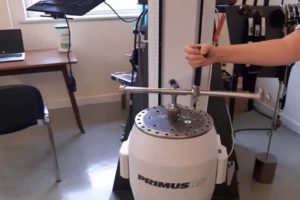
How To Care for Amputees in Rehab
Treatment GuidelinesAs an orthopedic PT, I frequently work with traumatic amputations. During assessment, I consider both the physical and mental / emotional impact of the patient's condition. Treatment addresses strength, flexibility, function, and emotional care.
Amputees are a special category of therapy clients who need careful consideration. As an orthopedic PT, I frequently work with traumatic amputations. My clinic specializes in workers’ compensation cases, so most of my clients’ amputations are related to a workplace injury. Here I will share my experience with this patient population, from evaluation to treatment and recovery.
The prevalence of people living with amputations is expected to double by 20501. At some point, you may have an amputee client, which could seem daunting at first. Most amputees spend more time with the rehab team than other providers, so your care has a big impact on their wellbeing.
Let’s explore how we can use a patient-centered approach to provide high quality care to amputees.
History
Spending extra time to gather a detailed patient history will help you perform purposeful testing. You will learn about their home environment, social support systems, status of other limbs, and comorbidities. Most importantly, you’ll learn what the patient wants to get out of therapy. Making collaborative goals is essential to ensure both you and the patient are on the same page.
Physical Exam
I usually start by inspecting the residual limb. Is the incision clean and intact? Is the limb shaped appropriately? Skin care will become very important for the patient, so it’s important that the therapist can educate on this point.
Next, I check the range of motion. Are there any contractures? Abnormal end feels? The available range of motion at proximal joints will also be of importance for various functional activities. The location of the amputation will determine which muscle groups I target for manual muscle testing.
Functional strength can also be valuable to determine what level of assistance a patient may need. Since vascular compromise and diabetes are the leading cause of surgical amputations1, it makes sense to check the sensation, proprioception, and vascularity of the intact limbs as well as the residual limb.
Finally, I evaluate balance, transfers, and functional activities. Once you have completed the exam, you will have a long list of impairments, most of which will be treated during your plan of care.
Looking to advance your functional assessment skills? Check out this article, Get Better Data from Your FCEs – Tips and Best Practices
Activity / Participation Limitation
In order to remain patient-centered, we should listen carefully to the client’s description of their condition. Questions I frequently ask are, “What activities do you have difficulty performing?” “What are some hobbies you enjoy or would like to get back to doing?” These questions can reveal goals that are meaningful to the patient and allow the therapist to prioritize treatments.
Phantom Limb
A common issue that amputees experience is phantom limb sensations. With this syndrome, patients experience numbness, tingling, itchiness, and pressure in a non-existent limb.2 Statistics show that phantom limb syndrome occurs in over 80% of amputee cases.3,4
Phantom limb sensation should not be confused with phantom limb pain. Although the two conditions are similar, phantom limb pain includes noxious stimuli such as burning, shooting, throbbing, stabbing and pricking.2 Determining whether they are experiencing sensations or pain will help you manage and decrease those symptoms.
Most individuals report a reduction in phantom limb sensations over time. But some report chronic phantom limb pain that limits their ability to use prosthetics and perform daily activities. The pain may worsen depression and / or anxiety, and even prevent them from attempting progressive treatment. The therapist should empathize with the patient and understand that these conditions can pose a huge fall risk, lead to denial, or even impact progress in rehab.
In terms of phantom limb sensations, the feeling of denial is a significant safety concern. Some patients believe their limb is still there and refuse to acknowledge the amputation. This denial can come from the fact that they still feel significant pain in the phantom limb.
As you can imagine, denial can create a fall risk because they try to move and function as if the limb were still there. It’s also a factor in compliance. For example, a patient won’t wear their prosthetic leg because they believe the limb is still there, and they will likely fall when they try to stand or walk.
Emotional Care
Amputees usually experience negative attitudes with feelings of anger, helplessness, and decreased self-esteem from their new body image.5 As one of their primary providers, you should be aware of their emotional wellbeing. You may even recommend seeking talk therapy or support groups to help during this process.
While talking to the patient, the most important emotional care you can provide is validation and empathy. Validate the patient’s feelings about their condition and any phantom limb perceptions. Empathize with what they’re going through and help them understand how you can help.
As healthcare providers, it’s important for us to remain optimistic yet realistic. When communicating with your patient, try to always use a calming tone, listen intently, and exercise patience.
While all amputations involve a loss, some people are relieved. Amputating a body part that was extremely painful can improve their quality of life. Remember that patients may journey through a wide range of emotions throughout treatment.
Patient Education
Best practice suggests that therapists provide clear advice with realistic expectations on rehab outcomes.6 Educating the patient on the importance of maintaining their skin care, home exercise plan, limb wrapping, and modifications will aid them in maintaining or increasing their independence. The interdisciplinary team will reiterate components of care throughout treatment.
Sometimes patients get frustrated when they can’t do tasks that they used to do before their amputation. During my sessions, I try to steer conversations toward what the patient CAN do. It’s important to empower the patient so they can be their own advocate in the future.
Conclusion
Undergoing an amputation is a life changing event. Amputees can seek treatment from many healthcare professionals, including rehab specialists. A thorough physical examination starts with the patient history. Understanding common symptoms, such as phantom limb, can help clinicians identify any additional precautions. Maintaining a calm, reassuring tone can make a huge difference in patients’ overall perceptions regarding their function – thus improving their quality of life.
Jazmine Shaw, PT, DPT is a Physical Therapist and freelance writer. She works as an outpatient orthopedic physical therapist at a worker’s compensation clinic in the Dallas/Fort Worth Area in Texas. Jazmine has experience working with a variety of orthopedic conditions, concussions, and amputees. She is passionate about helping individuals safely return to work. To get in touch with Jazmine, visit her Upwork page.
References
- Ziegler-Graham, K., MacKenzie, E. J., Ephraim, P. L., Travison, T. G., & Brookmeyer, R. (2008). Estimating the prevalence of limb loss in the United States: 2005 to 2050. Archives of Physical Medicine and Rehabilitation, 89(3), 422–429. https://doi.org/10.1016/j.apmr.2007.11.005
- Boomgaardt J, Dastan K, Chan T, Shilling A, Abd-Elsayed A, Kohan L. An Algorithm Approach to Phantom Limb Pain. J Pain Res. 2022;15:3349-3367
https://doi.org/10.2147/JPR.S355278 - Chahine, L., & Kanazi, G. (2007). Phantom Limb Syndrome-A Review.Middle East Journal of Anesthesiology, 19(2), 345
- Sahu, A., Sagar, R., Sarkar, S., & Sagar, S. (2016). Psychological effects of amputation: A review of studies from India. Industrial psychiatry journal, 25(1), 4–10. https://doi.org/10.4103/0972-6748.196041
- Şimsek, N., Öztürk, G. K., & Nahya, Z. N. (2020). The mental health of individuals with post-traumatic lower limb amputation: A qualitative study. Journal of Patient Experience, 7(6), 1665–1670. https://doi.org/10.1177/2374373520932451
- Department of Veteran’s Affairs. (n.d.). Rehabilitation of lower limb amputation (2017) – VA/DOD clinical …Retrieved November 4, 2022, from https://www.healthquality.va.gov/guidelines/Rehab/amp/





